|
Related FAQs: Angels, Angels
2, Angelfish Identification, Angelfish Behavior, Angelfish Compatibility, Angelfish Selection, Angelfish Systems, Angelfish Feeding, Angelfish Disease,
Freshwater
Angel Disease 2, FW Angel
Disease 3, FW Angel Health
5, FW Angel Health
6,
FW Angel Health 7,
FW Angel Health 8,
FW Angel Health 9, &
Angelfish Reproduction, &
FAQs on: Wild Angels (P.
altum), Discus, Neotropical Cichlids, Cichlid Fishes, Cichlid Systems,
Cichlid Identification,
Cichlid Behavior, Cichlid Compatibility, Cichlid Selection, Cichlid Feeding, Cichlid Disease, Cichlid
Reproduction,
Related Articles: Discus, Juraparoids/Eartheaters, Dwarf South American Cichlids,
Cichlids of
the World,
/A Diversity of
Aquatic Life
The Cichlid
Fishes Called Angels
|
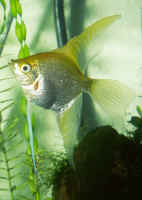 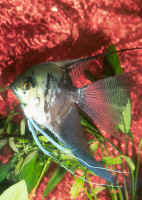
|
|
By Bob Fenner
|
Pterophyllum scalare
|
Since 1911 when the first freshwater angels were imported into
Germany (and the U.S. through the Brooklyn Aquarium Society in
1925), this South American Cichlid has gone on to become a staple
in our hobby interest. Or should I say staples due to the many
sport mutations, colors, finnage... varieties produced by earnest
aquarists? Indeed, by many estimates the freshwater angel,
Pterophyllum scalare, is THE most popular freshwater aquarium
species. And rightly so... the Scalare is a real beauty, and with
so much successive breeding very adapted to aquarium use.
Classification:
The three valid species of freshwater
angels, genus Pterophyllum ("tare-oh-fill-um") are
members of the Cichlidae, with some 1,300 described
species, the second largest (after the minnows) family of
freshwater fishes. Pterophyllum eimekei Ahl 1928 and P.
dumerilii (Castelnau 1855) are invalid, synonyms for P.
scalare. Apart from occasional shipments of "the"
wild angel, P. altum, all domesticated freshwater angels
are of the species P. scalare. For a discussion of
the nomenclatural history of these species please see Leibel,
1996.
| Pterophyllum
altum (Pellegrin 1903), Wild Angel. pH range: 4.8 -
6.2; dH range: 1.0 - 5.0, temp.: 27 - 31°C. South
America: Rio Amazonas basin, in the upper Rio Negro drainage;
Rio Orinoco Basin, in tributaries of the upper Rio Orinoco
(Rio Inarida, Rio Atabapo) to Puerto Ayacucho. To
about 8 inches in height. |

|
Bigger PIX:
The images in this table are
linked to large (desktop size) copies. Click on
"framed" images to go to the larger size. |
|
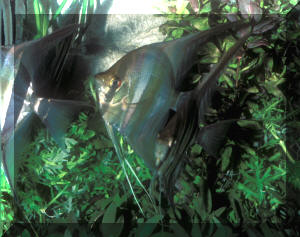
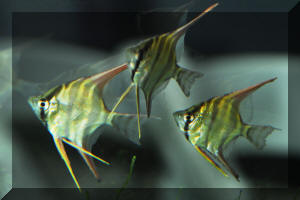
|
| Pterophyllum leopoldi (Gosse 1963).
the "Dumpy" Angelfish (in reference to it more
squat appearance). South America: Rio Amazonas basin, along
the Rio Solimões Amazonas between about Manacapuru
and Santarém; Rupununi River in the Essequibo
River drainage in Guyana. Infrequently offered in the
trade. |
|
| Pterophyllum scalare (Lichtenstein
1823), Angels of many sports. pH range: 6.0 - 8.0; dH range:
5.0 - 13.0, temp.: 24 - 30°C. South America: Rio
Amazonas basin, in Peru, Colombia, and Brazil, along the
Ucayali, Solimões and Amazonas rivers; rivers of
Amapá, Brazil, Rio Oyapock in French Guiana;
Essequibo River in Guyana. To about six inches in
height. Silver, gold koi and albino ones below. |
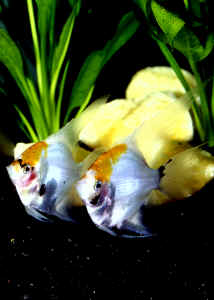 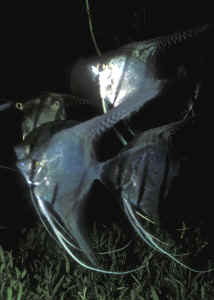
|
Bigger PIX:
The images in this table are linked to large (desktop size)
copies. Click on "framed" images to go to the
larger size. |
|
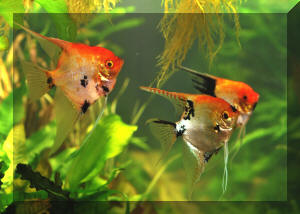
%20MD.jpg)
|
Habitat:
Though angels can be kept in small, plain
systems, they hail from shallow more still waters with dense
vegetation, and are happiest kept in larger tropical settings
with vertical plants, other decor like submerged wood and subdued
lighting.
Tanks: At least a forty gallon is preferable, something wider
than tall if possible to grant the angels a sense of being able
to "get away". Mated pairs of angels are often housed
in twenty gallon tall tanks. In community settings this volume
doesn't allow enough space for tankmates to hide from the
possible wrath of an aggressive angel.
Filtration: Most any scheme for providing biological,
mechanical and possibly chemical filtration will do for domestic
angels. They have been bred for so many successive generations
that they're now very adaptable to a widely varying range of
captive conditions. Wild angels (P. altum) are not quite
so forgiving however, and require high water quality of elevated
temperature.
Chemistry/Temperature: Domestic and wild angels originate in
very soft, acidic waters and are best kept in such. Though
Scalare's will tolerate a wide range of water quality, the
values stated above (pH range: 6.0 - 8.0; dH range: 5.0 - 13.0,
temp.: 24 - 30°C.) are the practical limits for their
care in captivity. Wild Altum angels are far less tolerant and
need water of lower pH and elevated temperature (pH range: 4.8 -
6.2; dH range: 1.0 - 5.0, temp.: 27 - 31°C.). All
angels prefer warm water, even the domestic species. The low to
mid 80's F are best. Even further elevated temperatures
(upper 80's) are employed for inducing
reproduction.
Compatibility: Tank-mate
Choices
Tankmate choices abound for what can be
kept with angels, however they are capable of swallowing small
fishes like tetras and can bedevil slow-moving, long-tailed
fishes like fancy guppies and Bettas. Best to house them with
other "mid-temperament" fishes like most Gouramis,
smaller barbs, dwarf to medium South American cichlids
(Apistogrammas, the festivum, Juraparoids...), or if practical in
a tank of their own perhaps along with other fishes found in
their native waters like armored and sucker-mouthed catfishes,
some of the larger easy-going characids (e.g. Hatchetfishes,
smaller Pencilfishes).
Often, the most disagreeable fishes to
place with angelfishes are other angels! Therefore the usual
admonition against crowding and suggestion that you buy/place all
the angels you intend to keep at the same time... and even then
remain vigilant in discovering and removing
bullies. Solitary angels can be/come tremendous terrors,
killing all of the other livestock in a system. Most overt
aggression will be eliminated by placing a number (six or more)
individuals in good sized systems (sixty or more
gallons).
Breeding, Rearing Young:
Angels of all varieties are
"stock" items in the hobby and business of ornamental
aquatics. And though they're amongst the easiest to breed and
raise young, there is seeming no end to demand for these fish.
Indeed, there are several folks in the U.S. and out that make
their living from such activity. Whether you've got designs
on making money or simply want to see if you can (or accidentally
do!) breed and raise angelfishes, there are some "Standard
Operating Procedures" to guide you along the way:
1) Selecting Breeders: is best done by stocking a large system
(sixty or more gallons) with six or more individuals and allowing
them to pair off. Be aware that this may take only a few months
and that there is a possibility that what you may end up with are
two females in pairs at times (and infertile eggs). Angels
can be sexed when "big enough" by the males having a
bulge (nuchal hump) on their "foreheads" and females
having a more "bent-in area" along their ventral margin
behind the pelvic fins. If they're expressed, the genital
pores are good indicators of sex (females are narrower, longer,
males more blunt, shorter). Making pairs by simply placing one of
both sexes can work out, but is more likely to result in fights
and death of one of the "pair".
2) Preparing the Breeding Tank: As previously stated, angels
can and will spawn in almost any size and type system. Commercial
operations frequently use 20 talls (24 X 12 X 18" usually)
as stock tanks here... keeping spawning pairs separated from
other fishes. You may be "surprised" by your angels
suddenly pairing off, driving off your other livestock and
"setting up home" in your community tank. If there is
room here or you have no other choice, there is a good chance you
may be able to successfully hatch out and even raise young in
place... However, there are many good reasons why folks in the
trade choose to house their spawning pairs in their own systems
and raise their young independently. Most all these concerns are
related to control, preserving the life and vitality of livestock
and maximizing production.
Water quality and consistency can make or
break your efforts at successful spawning. Softer water of
neutral (7.0) pH or lower is required. Folks with hard, alkaline
source water can blend in reverse osmosis or deionized water, use
chemical additions like "blackwater tonic" or
ostensibly make their own with the use of dark peat (boiled and
sandwiched between layers of mechanical filter floss).
Temperatures in the mid to upper 80's F. are useful in
inducing spawning.
Angels breed on vertical or near-vertical
surfaces. Some aquarists prefer "natural" materials
like swordplant (Echinodorus) leaves, others use materials like
slate or clay flower pots that can be easily removed, sterilized,
stored between deployment. If no other surface is available,
ready spawners will place their eggs on aquarium walls, filter
parts, glass heater tubes... much better to provide a suitable
spawning substrate.
For biological filtration either sponge
type or corner filters are ideal for cycling wastes, providing
aeration and circulation. Outside power filtration can work for
the breeder tanks, but is more expensive to procure and operate
and ill-advised for systems with free-swimming young. Undergravel
filtration is wholly unsuitable for either.
3) Rearing the Young:
Requires adherence to a regular routine of
mainly two foci: maintaining water quality and nutrition. In
ideal settings, you have either a semi- or totally open system
where you can drip in new fresh tapwater that has had the
sanitizer (usually chloramine, sometimes chlorine) removed,
heated and possibly chemically altered to use, with the mixed/old
water overflowing to waste. This constantly flushing set-up
provides the optimum decrease in metabolite accumulation,
spurring on the growth of the young. In most settings things are
quite so ideal, and the "closed" systems in use require
more filtration, and manual water changes... daily to every few
days.
Commercial breeders often remove the
provided spawning media to another small volume (sometimes drum
bowls) other times rectangular aquariums with an anti-fungal like
Methylene blue and mechanical aeration (e.g. an airstone) placed
near the eggs to provide circulation like their dolting
parents.
Foods for the young need to be small enough
to ingest (infusoria, liquid prep.s, freshly hatched brine shrimp
are very often utilized, ground up flakes and pelletized foods
coming later) and offered FREQUENTLY. Some commercial breeders
feed ten, twelve or more times daily... to maximize growth and
reduce intraspecific aggression. This last can be a real source
of trouble and loss, with some "super growers" turning
on their smaller siblings to the point of their loss.
Which brings up the twin issues of culling
and sizing. Some to several of the young from any given
spawn or pair are going to be deformed, or behaviorally "not
right" or both... and should be summarily disposed of
(frozen, fed to other stock...) to allow better growth, living
conditions for the remaining stock. There is differential growth
in batches of young as well, and the larger, faster growing
individuals need to be sorted/removed to other quarters to
discount intraspecific aggression and allow their smaller kin
opportunities for food, space.
Foods/Feeding/Nutrition
Due to their captive
"plasticity", domestic angelfishes are very easy to
feed. They will readily take most any foods small enough to fit
their diminutive mouths. Live foods like tubificid worms,
Daphnia, brine shrimp, chironomid larva ("glass worms")
et al. are taken with relish. Do endeavor to supply these foods
as part of your angels standard diet, particularly if you're
interested in conditioning for spawning or raising your
Pterophyllum for show. Dried prepared foods as flakes, pellets,
sticks are also greedily accepted by these fish, as are all
suitably-small sized freeze-dried foods.
Diseases:
Angelfish are susceptible to the two most
common parasitic diseases of freshwater tropicals, ich and
velvet, though they tend to be more resistant to these scourges
than other fish groups. Two other protozoan complaints, Hexamita
and Spironucleus can be sources of great and continuing losses of
Pterophyllum, sometimes resulting in hobbyists quitting their use
and stores giving up carrying them altogether. Quarantine of new
stocks and treatment with Metronidazole (Flagyl, in water at 5
mg/l or foods) can curtail these losses. Symptoms of these
organisms presence include blood streaking in the fins
(hemorrhagic septicemia), clear to whitish feces, ataxic behavior
of hosts.
For beauty, grace, hardiness (except for
wild types), overall adaptability and diversity freshwater
angelfishes are unparalleled amongst aquarium fishes. Keeping and
for many, breeding them is a rite of passage for the personal
evolution of many aquarists.
Angelfish Book Recommendations - 08/05/06
Hi I am a long time user of your website from India. Recently I
have set up a 50g tank for angelfish. It is a planted tank with
vals & E. tenellus. Can you suggest some good books on
angelfish?. Thanks Sandeep R < Not too many books dedicated to
angelfish these days. I would recommend "Enjoying
Cichlids" by Ad Konings. It is available from Cichlid Press.
it is a great book that will help you will all aspects of keeping
cichlids. Angelfish are cichlids by the way. lots of info on
feeding, filtration and water chemistry to keep any cichlid you
want.-Chuck>
Bigger PIX:
The images in this table are
linked to large (desktop size) copies. Click on
"framed" images to go to the larger size. |
| Isn't that pretty? Some Gold Flake angel pix. |
.JPG) .JPG) |
Bibliography/Further
Information:
Angels Plus http://www.angelsplus.com
The Angelfish Society: http://www.aquaworldnet.org/tas/
http://websvirginia.com/angels/moreinfo/index.htm
Axelrod, Herbert R. 1985. The angelfishes, Pterophyllum. TFH
4/85.
Dawes, John. 1988. An update on the angelfish dilemma.
"Singapore disease" is said to be threatening worldwide
supplies of angelfish, yet a big market still exists for healthy
livestock. Pets Supplies Marketing 7/88.
Dow, Steven. 1978. Compatibility dating with angelfish? FAMA
5/78.
Dow, Steven. 1980. Breeding those elusive black and black-veil
angelfish. FAMA 2/80.
Dow, Steven. 1987. Notes on the artificial incubation of
angelfish eggs and embryos. TFH 9/87.
Kowite, William J. 1985. Angelfish: observations on genetics
and parental care. FAMA 5/85.
Lango, William. 1986. How to keep, raise, and breed angelfish.
FAMA 10/86.
Leibel, Wayne S. 1996. Angelfish. One of the
"pancake" cichlids. AFM 10/96.
Levy, Harold. 1953. Secrets of egglayers. The angel fish
(Pterophyllum scalare). TFH 1:3(53).
Loiselle, Paul. 1996. Angel sex. How to tell the boys from the
girls in angelfish. AFM 7/96.
Maurus, Walt. 1978. The most kept tropical fish in the U.S.A.
FAMA 9/78.
Murray, Renee R. 1992. Healthy angelfish are within your
reach. FAMA 4/92.
Newman, Lee. 2004. Ready to take the nest step with angelfish?
Breed some wild ones. AFM 7/04.
Norton, Joanne. 1981. Angelfish breeding tips. FAMA 8/81.
Norton, Joanne. 1982. Angelfish genetics. 4,5/82.
Norton, Joanne. 1988. Freshwater angelfish care and breeding.
AFM 10/88.
Norton, Joanne. 1988. From egg to adult. Raising freshwater
angelfish. AFM 12/88.
Phillips, Todd A. 1988. Raising baby angelfish. FAMA 5/88.
Schiff, Steven J. The angelfish aquarium FAMA 7/99.
Thompson, Richard W. 1989. The altum angelfish: a guide to
keeping a rarely seen beauty. AFM 12/89.
Walker, Braz. 1974. Angelfish. TFH Publications. Inc. Neptune
City, NJ.
Walker, Braz. 1976. Unexplained angelfish breeding failures.
TFH 5/76.
Webster, Kent. 1993. Black pearl angelfish. FAMA 1/93.
|

